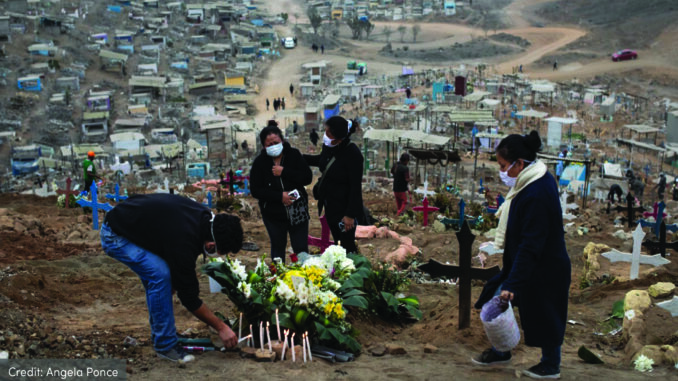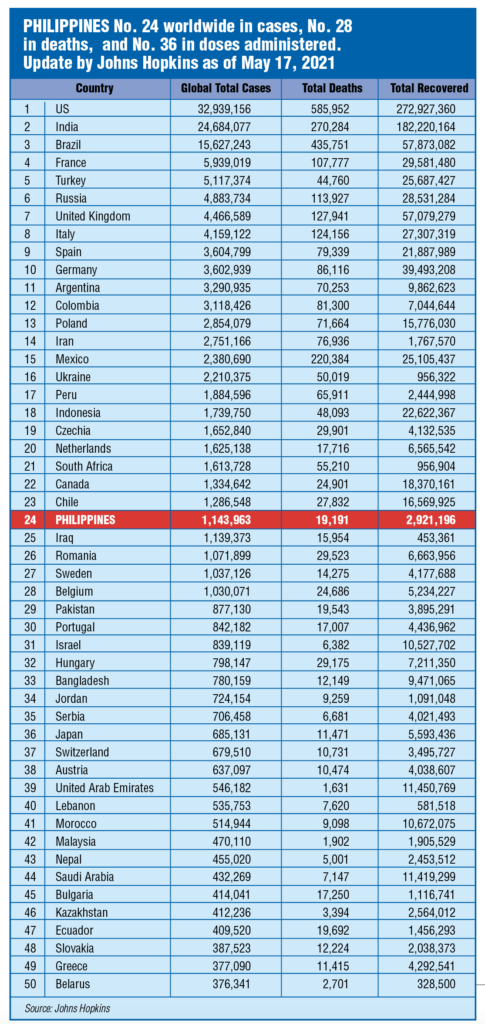
A rather ponderously named Independent Panel for Pandemic Preparedness and Response (IPPPR or simply the Panel) of the World Health Organization has called COVID-19 the 21st century’s Chernobyl moment—“not because a disease outbreak is like a nuclear accident, but because it has shown so clearly the gravity of the threat to our health and well-being.”
“It has caused a crisis so deep and wide that presidents, prime ministers and heads of international and regional bodies must now urgently accept their responsibility to transform the way in which the world prepares for and responds to global health threats. If not now, then when?” said the Panel in its report dated May 12.
COVID Moment
It should be “The COVID-19 Moment”, not the Chernobyl Moment. The April 26, 1986 nuclear accident in Ukraine, then under the USSR, cannot compare with the death and devastation wrought so far by COVID-19. About 47 died after the Chernobyl accident, the worst in the past century, during the years 1986-2004.
COVID-19 so far, after 16 months, has sickened 163.4 million and killed 3.38 million in 223 countries, including 17,000 health workers who died in the first year of the pandemic. About $10 trillion in economic output was lost in 2020 and $22 trillion in the period 2020–2025 — “the deepest shock to the global economy since the Second World War and the largest simultaneous contraction of national economies since the Great Depression of 1930–32,” said the Panel.
Philippine situation
The Philippines, at this writing, has 1.138 million cases and more than 19,000 deaths. An average of 100 Filipinos die daily from COVID-19, despite a slowdown in case escalation.
• At pandemic’s peak in 2020, 90% of schoolchildren were unable to attend school;
• 10 million more girls are at risk of early marriage because of the pandemic;
• Gender-based violence support services have seen fivefold increases in demand;
• 115–125 million people have been pushed into extreme poverty.

Rued the Panel: “Most dispiriting is that those who had least before the pandemic have even less now. The experience of previous epidemics shows that income inequality increased in affected countries over the five years following each event. Those working in the informal sector have had little or no support. Migrants, refugees, and displaced people have often been shut out of testing services and health facilities. Perhaps 11 million of the poorest girls in the world may never go back to the classroom. People living in the poorest countries are at the tail-end of the vaccine queue.”
President Duterte should listen to this:
The Panel said: “This pandemic has shaken some of the standard assumptions that a country’s wealth will secure its health. Leadership and competence have counted more than cash in pandemic responses. Many of the best examples of decisive leadership have come from governments and communities in more resource-constrained settings. There is a clear opportunity to build a future beyond the pandemic that draws on the wellsprings of wisdom from every part of the world.”
The rich countries, which have administered one billion doses of vaccine to their citizens, triple their combined population; compared to 1% for the rest of the world.
Access a global challenge
The Panel said: “The uneven access to vaccination is one of today’s pre-eminent global challenges. High-income countries have over 200% population coverage of vaccine doses, obtained mainly through bilateral deals with manufacturers to secure existing and future stocks. In many cases low- and middle-income countries have been shut out of these arrangements.”
About 5.7 billion adults need the vaccine now. And it is not available. COVAX, the WHO’s vaccine facility for the have-nots, has secured so far only 1.1 billion doses, plus 2.5 billion doses on option. Yet, additionally, after 2021, 5 billion booster doses will be needed yearly, the Panel estimated.
According to the New York Times, “the world is nowhere close to having enough. About 11 billion shots are needed to vaccinate 70% of the world’s population, the rough threshold needed for herd immunity, researchers at Duke University estimate. Yet, so far, only a small fraction of that has been produced. While global production is difficult to measure, the analytics firm Airfinity estimates the total so far at 1.7 billion doses.”
US fails the moral test on vaccines
In an editorial, “America is Failing in Its Moral Test on Vaccines”, May 14, 2021, NYT said: “The United States is well on its way to protecting Americans from the coronavirus. It’s time to help the rest of the world. By marshaling this nation’s vast resources to produce and distribute enough vaccines to meet global demand, the United States would act in keeping with the nation’s best traditions and highest aspirations while advancing its geopolitical and economic interests. It is a moment of both obligation and opportunity.”
The editorial added: “Without a major course correction, the rest of the world will have to wait until 2023 or later for large-scale vaccination initiatives like the one underway in the United States. The consequences of this disparity are expected to be severe. Hundreds of thousands more people will get sick and die from a disease that is now preventable with a vaccine. The global economy will contract by trillions of dollars, according to the International Chamber of Commerce, and tens of millions of people will plummet into extreme poverty as the virus continues to fester and evolve in the world’s more vulnerable reaches.”
“As global hunger rises and global life expectancy falls, instability will prevail,” the NYT editorial board said.
Responsibility at the highest level
The WHO Independent Panel also said:
“Pandemic preparedness planning is a core function of governments and of the international system and must be overseen at the highest level. It is not a responsibility of the health sector alone.”
“Zoonotic outbreaks are becoming more frequent, increasing the urgency for better detection and more robust preparedness. Given the increasing stakes, monitoring pandemic threat needs to be on the agenda of decision-makers at the highest levels of governmental, intergovernmental, corporate and community organizations.”
The Panel was led by former Liberia President (2006-2018) Ellen Johnson Sirleaf and former New Zealand PM (1999-2008), Helen Clark with 11 other former heads of government, senior ministers, health care experts and members of civil society as members. None from the Philippines.
My conclusions after reading the Panel’s report:
Simply, the panel wants countries to:1) prepare for the next pandemic (treat pandemic as the next disaster); 2) have a pandemic coordinator with full powers and access to the nation’s leader (that means no more General Galvezes and Sec Duques—asl); 3) invest in health; produce the vaccine yourself, including essential supplies; 4) get technology transfer for vaccines thru waiver of royalties; and 5) finally, revamp WHO, meaning fire the incumbents enjoying almost lifetime sinecures in that agency.
WHO has become a captive of China. It was slow to blame China for the outbreak, slow to declare corona a pandemic, leaving governments wholly unprepared.
Said the Panel: “Clinicians in Wuhan, China, were quick to spot unusual clusters of pneumonia of unknown origin in late December 2019. The formal notification and emergency declaration procedures under the International Health Regulations, however, were much too slow to generate the rapid and precautionary response required to counter a fast-moving new respiratory pathogen. Valuable time was lost.”
WHO’s moral ascendancy
The fact that WHO cannot tell rich countries to give vaccines to poor countries betrays its diminished authority and moral ascendancy.
By the way even the expert panel report held its punches. It doesn’t blame anyone either. This shows you how powerful China has become.
If there is a lesson from this pandemic it is that nations are not united in the face of a common global enemy. It is to each his own, just like the tribes of ancient times. Martians will easily conquer the earth. Humanity failed itself. The COVID-19 pandemic is mankind’s failure of the century.
READ FULL ARTICLE HERE:

